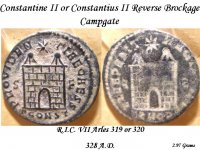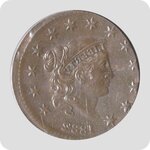Gunner
Sr. Member
- Dec 19, 2004
- 340
- 1
Here is an interesting piece I just got in the mail today. It is a "reverse brockage" campgate AE of either Constantine II or Constantius II. Reverse brockages are quite rare. Obverse brockages (the kind where the "heads" side of the coin is incuse on the reverse of the coin) are more common and tend to appear frequently on Roman Republican denarii. A brockage occurs when an already struck coin gets stuck in one of the dies and the coin serves as a die for the next blank. This produces an incuse/mirror image impression of one side on the other side. Most brockages are obverse brockages, because the obverse die was generally affixed to the workbench, while the reverse die was held with iron tongs for striking. The workers would have to have been either in a hurry or didn't care when the coin became stuck in the tong portion of the die as this would be easily seen.
Gunner
Gunner
Amazon Forum Fav 👍
Attachments
Upvote
0







